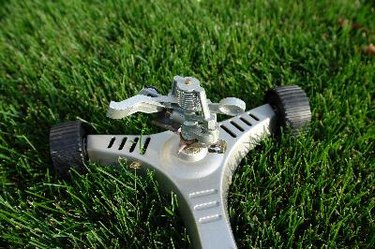
Drip irrigation is a method of watering all types of plants that conserves water, saves money on your water bill and delivers water only to the plants' root zones, where it is needed most. You can create a complicated, extensive drip system or keep it simple by purchasing a kit that includes all the hoses, emitters and other components you'll need. If you install a timer, you'll save even more time.
Parts of a Drip System
Video of the Day
A basic drip system contains a ½-inch black polyvinyl hose line, emitters of various sizes, end caps and often parts called a vacuum breaker, hose connector and pressure regulator. If you purchase a drip kit, it will also include a hole punch, which will enable you to install emitters next to the plants you need to water. Emitters deliver varying amounts of water, which is known as "GPH" or "gallons per hour."
Video of the Day
Small Emitters for Small Plants
Install one ½ GPH emitter at the base of small plants, such as herbs. If you normally water small plants with 2 cups (1 pint) of water, run a system made up of ½ GPH emitters for 15 minutes (1/4 of an hour) each time you run the system. This will deliver approximately 1 pint of water, or 2 cups. The frequency varies: water more often during hot, dry weather and less often during cooler weather.
Medium Emitters for Medium Plants
Plants such as tomatoes, peppers, eggplant, corn and other medium-sized plants need about 1 gallon of water each time you run your drip system. If you have installed 1 GPH emitters at the base of those plants, run your system for one hour. Tomatoes grow best when their soil dries out between waterings, so check the moisture with your finger before you water again. You might find that you should run it less often, but longer for tomatoes.
Large Emitters for Large Plants
Trees and other large plants also benefit from drip irrigation. Use 3 GPH emitters for larger plants and consider encircling the plant with your drip line and installing two to four 3 GPH emitters at evenly-spaced distances around the tree. For example, pecan trees need large amounts of water; if you install four 3 GPH emitters around your tree and run the system for one hour twice a week, the tree will receive 24 gallons of water each week.